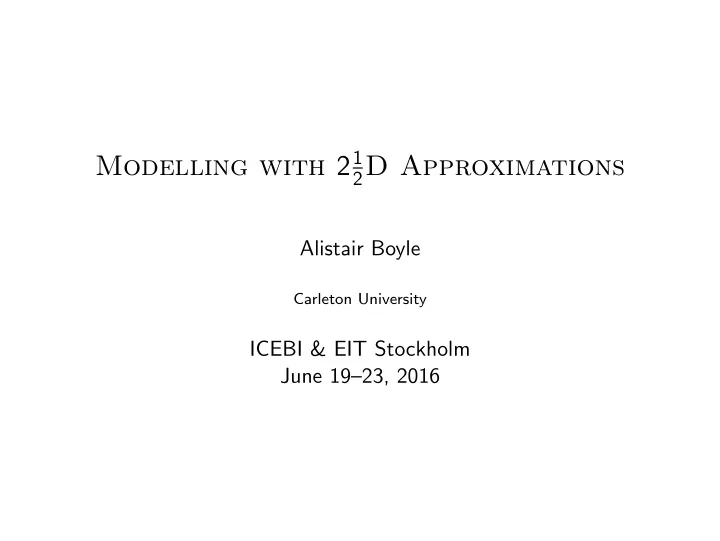

Modelling with 2 1 2 D Approximations Alistair Boyle Carleton University ICEBI & EIT Stockholm June 19–23, 2016
Motivation 2D Models are Wrong (some of the time) A. Boyle, 2016 Carleton University 2 1 / 2 D Approximations 2 / 13
Motivation 0.5 0.45 2D 0.4 0.35 measurement [Volts] 0.3 0.25 0.2 0.15 0.1 2 1 / 2 -D, 3D, analytic 0.05 0 0 5 10 15 20 25 30 35 measurement # analytic FEM 2.5D FEM 3D FEM 2D A. Boyle, 2016 Carleton University 2 1 / 2 D Approximations 3 / 13
Motivation 0 -50 = z [m] -100 -150 -60 -40 -20 0 20 40 60 80 100 120 140 x [m] 2D Models are Still 3D with a uniform field in z and infinite electrodes A. Boyle, 2016 Carleton University 2 1 / 2 D Approximations 4 / 13
Motivation � = Electrodes are Finite but detailed 3d models are expensive A. Boyle, 2016 Carleton University 2 1 / 2 D Approximations 5 / 13
What If conductivity is uniform in z ... A. Boyle, 2016 Carleton University 2 1 / 2 D Approximations 6 / 13
Transform then we can make use of Fourier transforms � ∞ ˜ φ xyz cos(˜ k = kz ) dz (1) φ xy ˜ F 0 −∇ · ( σ xy ∇ ˜ k ) + ˜ k 2 σ xy ˜ k = ˜ φ xy ˜ φ xy˜ Q δ xy (2) � ∞ φ xyz = 2 ˜ k cos( ˜ kz ) d˜ F − 1 k (3) φ xy˜ π 0 A. Boyle, 2016 Carleton University 2 1 / 2 D Approximations 7 / 13
Fourier 2 1 2 D 0.035 2 1 / 2 -D, analytic 0.03 3D 0.025 measurement [Volts] 0.02 0.015 0.01 0.005 0 5 10 15 20 25 30 35 measurement # analytic FEM 2.5D FEM 3D A. Boyle, 2016 Carleton University 2 1 / 2 D Approximations 8 / 13
Compute Time 4 3 . 27 run time [sec] 3 2 1 . 32 1 0 . 23 2 · 10 − 2 0 analytic 2D 2 1 3D 2 D A. Boyle, 2016 Carleton University 2 1 / 2 D Approximations 9 / 13
Compute Time system matrix fwd solve 0.226 sec 0.039 sec 2D 0.222 sec 0.906 sec for 25 k 2 1 2 D 2.966 sec 0.149 sec 3D A. Boyle, 2016 Carleton University 2 1 / 2 D Approximations 10 / 13
Another 2 1 2 D Method with a dual-mesh 0 -50 + z [m] -100 -150 -60 -40 -20 0 20 40 60 80 100 120 140 l e x [m] d o m d inverse model r a w r o f same geometry but expensive forward solution A. Boyle, 2016 Carleton University 2 1 / 2 D Approximations 11 / 13
Another 2D Method with a dual-mesh 0 0 -50 -50 + z [m] z [m] -100 -100 -150 -150 -60 -40 -20 0 20 40 60 80 100 120 140 -60 -40 -20 0 20 40 60 80 100 120 140 x [m] x [m] forward model inverse model same geometry but in expensive forward solution A. Boyle, 2016 Carleton University 2 1 / 2 D Approximations 12 / 13
Fourier 2 1 2 D Now Available in EIDORS % fwd_solve: img.fwd_model.solve = @fwd_solve_2p5d_1st_order ; img. fwd_solve_2p5d_1st_order .k = [ a .. b ]; % optional img. fwd_solve_2p5d_1st_order .method = ’name ’; % optional % k as integration range , default: [0 Inf] % method as ’trapz ’ ’quadv ’ (default) or ’integral ’ % inv_solve: imdl.fwd_model.solve = @fwd_solve_2p5d_1st_order ; imdl.fwd_model.jacobian = @jacobian_adjoint_2p5d_1st_order ; imdl.fwd_model. system_mat = @system_mat_2p5d_1st_order ; A. Boyle, 2016 Carleton University 2 1 / 2 D Approximations 13 / 13
Recommend
More recommend